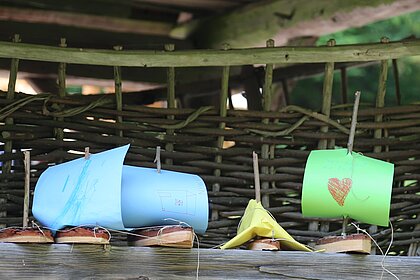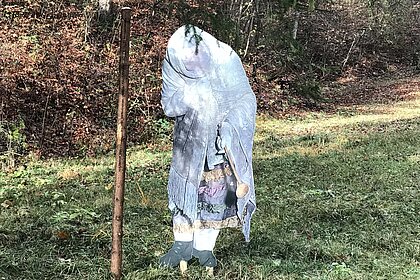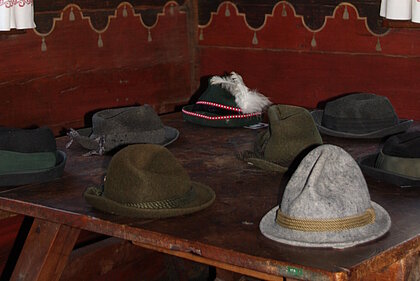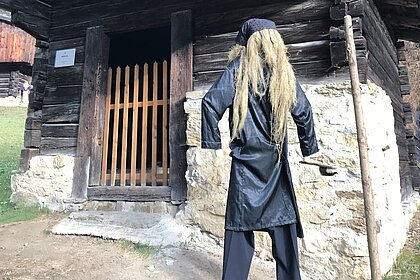Autumn and winter merge into one another in many ways. For thousands of years, people have tried to drive away evil spirits during this dark time. With the introduction of Christianity, additional customs and traditions were added that can be found around Advent and Christmas. The cold temperatures and the few hours of sunshine encouraged necessary tasks as well as social entertainment in the houses.
Customs and traditions in winter
Time for socializing

Image Credits
Setting ships
In the Mariazell region, a loving tradition has been established that is celebrated every year on the evening before St Nicholas' Day: the “Schifferlsetzen” (setting ships). On this special evening, the children craft colourful paper boats with lots of creativity and joy, which they design with sayings and artistic decorations. These little works of art are not only an expression of anticipation for the upcoming festivities, but also part of a mysterious game. The children set off to secretly place their self-made boats with relatives, friends, neighbours and godparents. It is important not to get caught, which adds to the excitement of the custom. The night is filled with whispers and laughter as the little ‘Schifferlsetzer’ search for suitable places for their colourful boats. Whoever finds one of these little boats has the task of filling it with delicious treats such as nuts, almonds, apples, chocolate and a variety of sweets. These sweet surprises are then lovingly placed in the boats and made ready for the children to collect their treasures the next day. This custom brings the community together and creates unforgettable memories that are passed down through the generations.

Image Credits
Saint Lucia
Commemoration day: 13 December, patron saint of the blind, seamstresses, farmers, tailors, saddlers, glaziers. Attributes: Lamp, candle, torch, sword, 2 eyes on a bowl. In earlier times, St Lucy's Day was regarded as the night of lots and oracles. According to old superstition, the house and stables had to be swept clean by the evening, otherwise a witch would come during the night and wreak havoc on the untidy maids. In eastern Austria, it was and still is traditional in some places for the friendly but silent mother poodle to go from house to house on 13 December. An old, stooping "Weiberl" (old lady) with a headscarf or cloak pulled low over her face, who wordlessly rolls apples, nuts, biscuits and other treats from her basket or apron into the parlours. This rolling in was once called "pudeln", hence its name. In contrast to the friendly "Pudelmutter" is the witch-like "Luzelfrau", who, covered in white with a chain, a broom or a wooden spoon in her hand, punishes the lazy and rewards the hard-working.

Image Credits
Lösseln or lifting hats
On 21 December, St Thomas' Night marks the beginning of the mystical Rough Nights, which last until Epiphany. This longest night of the year was considered to be particularly significant, as it allowed for numerous oracles and prophecies. A favourite custom among the girls was shoe throwing: With their backs to the door, they would throw their shoe back over their heads. The shoe whose tip pointed towards the door revealed who would soon be getting married. On this magical night, young and old gathered to enjoy the traditional entertainment of "Lösseln" with hats. After dinner, the boys and girls of the neighbourhood met in a house. There, nine different symbols were hidden under hats. Lifting the hats revealed many an interpretation of the future: a ball of thread stood for a long life, a doll heralded the arrival of a child, while a ring signalled an impending marriage. A coin promised wealth, a loaf of bread heralded hunger or even a fling, and a comb symbolised poverty. A key symbolised the household, a knife warned of misfortune and a wooden travelling peg indicated an imminent journey. Unfortunately, due to the often threatening possibilities, many of these customs have almost disappeared today, but they remain a fascinating chapter in cultural traditions.

Image Credits
Perchten
The "Frau Percht" appears in two forms: a good, friendly figure and an evil, punishing one. She could also take on animal forms. The "Schnabelpercht" is particularly well known and goes around the Rauris Valley in Salzburg on 5 January. She wears a beak mask and a humped basket with children's legs, armed with scissors or a broom. The Schnabelpercht inspects households for cleanliness and gives gifts to hard-working maids, while she slashes the bellies of lazy people. People fear her and prefer to give her gifts to keep her away. In Ausseerland and Viechtau, the "Berigln" are on the move. These figures check houses for tidiness and bring good luck, but reprimand untidy households. The "Berigln" are appeased with Schnaps, Perchtmilch or Krapfen (like doughnuts) and write three crosses on the front doors. In Carinthia, the "Frau Percht" appears as an old woman with a soot-blackened face and demands "children or bacon". As a defence, the "Perchtrajagen" is carried out, in which boys light a fire and a boy dressed as Perchtra jumps over it. The Percht is chased out of the village with shouting and cowbells, but on the way back the bells must remain silent or she will return.



















